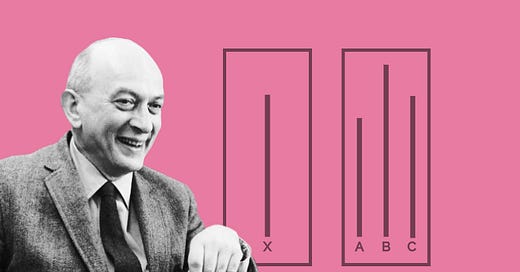Social influence shapes behavior, thoughts, and emotions by leading people to adjust their beliefs or actions to align with others, often unconsciously. Conformity, a major aspect of social influence, involves changing behavior to fit group expectations, sometimes at the expense of personal values. Classic studies, like Solomon Asch’s experiments, demonstrate how peer pressure can override individual judgment, even in clear-cut situations.
The Asch Experiment
In the 1950s, Solomon Asch (1907-96), a pioneering Polish-born American psychologist, conducted a landmark study on conformity.
Participants were asked to match line lengths in a group setting, but unknown to them, they were surrounded by confederates instructed to give incorrect answers. The lines being compared were clearly and unquestionably of different lengths, making the correct answer obvious.
The results revealed that 75% conformed to the incorrect majority at least once, and about one-third conformed regularly. Many participants admitted knowing the correct answer but felt pressured to go along with the group, fearing judgment or social isolation. The study underscored how social pressure can override independent thinking, even in simple tasks.
Normative Social Influence: This occurs when people conform to gain social acceptance or avoid rejection, even if they disagree privately. For example, teenagers may adopt fashion trends, slang, or risky behaviors to fit in with peers. Similarly, employees might pretend to support a popular workplace initiative to avoid standing out or facing criticism. The need for belonging often outweighs personal opinions.
Informational Social Influence: When people are uncertain about a situation, they look to others for guidance, assuming the majority knows best. This is common in unfamiliar settings—such as tourists following a crowd to find an attraction or new employees mimicking workplace norms to adapt.





Thanks for lifting up Asch’s findings! Gaining awareness of this all-too-human tendency to yield to such pressures is surely the first step in being better able to resist those pressures, and think for oneself.
Yes, and MRI tests suggest that the people who conform actually see the line's length incorrectly. Meanwhile, nonconformists (hello!) react emotionally to the pressure to conform. https://www.nytimes.com/2005/06/28/science/what-other-people-say-may-change-what-you-see.html?unlocked_article_code=1.vE4.yAw6.96QSKrTW7B0a&smid=url-share